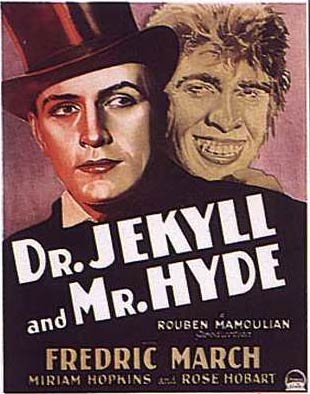 Dr. Jekyll and Mr. Hyde, directed by Rouben Mamoulian and released in 1931, is an outstanding tribute to the story originally written by Robert Louis Stevenson.
Dr. Jekyll and Mr. Hyde, directed by Rouben Mamoulian and released in 1931, is an outstanding tribute to the story originally written by Robert Louis Stevenson.
Throughout this movie, Dr. Jekyll (Fredric March) believes there are two different sides to men – a good and an evil side. If the two are disconnected, man can become liberated. Dr. Jekyll decides to experiment with chemicals. When drinking these, he transforms into Mr. Hyde, whom commits horrible and dangerous crimes. When Dr. Jekyll decides to stop before any farther harm is done, it is too late to change what he has done to the atmosphere and individuals around him.
Certain people who have watched the 1931 Dr. Jekyll and Mr. Hyde, have dissimilar opinions towards the film.
The director, Rouben Mamoulian, was able to create a perfect version of Robert Louis Stevenson’s spine-chilling tale. With ghostly gas-lit scenes of London and an amazing cast, this is the most accurate tale of this classic apologue.
For a 1931 film, there were great effects included and some incredible performances. Whenever Dr. Jekyll transformed into Mr. Hyde, it was simply astonishing every time, noticing the realistic outlook it gave.
Staring as both Dr. Jekyll and Mr. Hyde, March was a much more effective actor compared to the others who have taken up the role in future versions of the film. When transforming into Hyde, with the help of extremely heavy make-up, the alterations March does to his voice, walk, and body movements are so remarkable that it seems as if two different actors were being used for Dr. Jekyll and Mr. Hyde. The make-up used throughout the film allowed the phenomenal piece of work to be highly convincing.
The film makes it clear that Hyde’s appearance is due more to Jekyll’s crude sexual frustration (note Hyde’s hairy hands) than to any appropriate bloodlust.
Dr. Jekyll encounters appalling consequences when he lets his unpleasant self run untamed with the chemical that changes him into the animalistic Mr. Hyde, making the flick enjoyable.
On the other hand, there were negative elements about the movie, which included unapparent mistakes.
At the beginning of the film, when Jekyll is putting on his cape in the “mirror,” a crew-member’s reflection can be recognized fluttering across his stomach in the glass. Also, while Hyde first visits the Variety Music Hall, he stretches over a railing in order to attempt to trip a waiter with his cane. Trying to grab his cane, he stumbles. This causes him to knock his top hat off the railing. The hat ends up landing on the floor next to the waiter. During the scene, Hyde is somehow still holding onto his hat while striking his cane.
Some mistakes can easily be seen, but these are a few things that may bother some audiences, where other people probably would not have realized these things when watching the showing for the first time.
Rouben Mamoulian’s Dr. Jekyll and Mr. Hyde demonstrated a significance quite distinctive from other films.
The significance was simply in the name of a character.
“Hyde” is very much alike to the word “hide.” Mr. Hyde somewhat symbolizes concealed emotion or desire; the things we would like to do, but do not because of moral or social authorization. The acts Hyde commits are those most people would only think of doing. Therefore, Hyde represents the emotions and desires we have no choice but to “hide” away.
While some of the acting, dialogue, and script may now seem mischievous, this resides an exceptional outcome on the classic novel, visually watchful and notably strong given the era in which it was made.

Leave a Reply